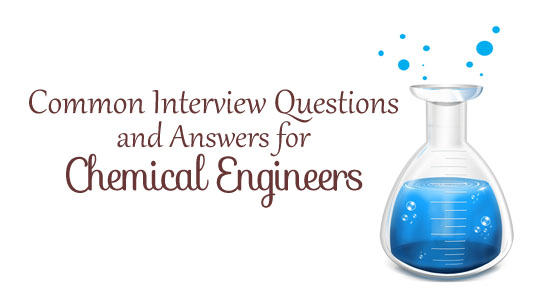The best career choice presently where qualified professionals are in high demand in chemical engineering. The main role of a chemical engineer is to gather materials, design processes so that few properties altered to offer them another purpose.
There are ample industries that entrust chemical engineers to produce new materials. Hence, their role in any industry leads to many opportunities.
Large scale processes designed by chemical engineers where they convert raw materials, living cells, microorganisms, chemicals and energy into beneficial products.
To get recruited to the best organization, prior preparation for an interview is mandatory.
In that aspect let’s glimpse through a few common interview questions for chemical engineers.

Chemical Engineering Interview Questions and Answers:
1. What is flow control?
Flow control mentioned as an optimized production technology where the effectual flow of material concentrated utilizing the production process. Bottlenecks are the main aspect that the flow control philosophy focuses on.
A simple example can be that the owner who makes use of the flow control process would never intend to purchase machines that have a capacity of 1000 units per hour and supply just 500 units.
The systems are to analyze and the lowest flow must identify. The identified point must address and assured that it works to its full capability. When maximum productivity required, flow control plays its role.
2. Mention the difference between unit operation and unit process?
When a unit operation considers changes take place in mass and concentration where energy provided from an external source without any chemical change. A few examples would be evaporation, distillation, and mixing.
In the same manner, when a unit process considered, the reactant processed in the feed which means that reactants present in the feed transformed to products utilizing the chemical reaction and with the assistance of energy supplied to the system.
3. What is the solvent?
A solvent can define as a liquid that can suspend, dissolve or take out other chemicals where they do not perform any chemical change to the material or solvent. The main process of solvents is to clean, apply, processor to separate materials.
4. What is material requirement planning?
When the number of finished goods provided it requires an appropriate quantity of raw materials and related components to make them.
Computerized tools that used to handle at times materials ordered to supply a later date called, material requirement planning system.
When output quantities know, then MRP is effective. There are several small business owners these days that have their MRP system.
In this way, they store the information required and supply production. Few MRP activities are forecasting demand and computer tracking inventory.
5. What are PCBs?
The abbreviation for PCB is “Poly Chlorinated Biphenyls” and is mainly utilized for disposal issues usually in the chemical industry.
6. What are the design considerations for a piping system to transfer slurries?
The points considered to design a pipe to transfer slurries mentioned. The pipe should have the capability to self-drain, in the case where self-drain isn’t possible manual draining facility should be installed.
The other point to mention is that when plugging opportunities are high, blow-out or rod-out connections must provide to clear the lines.
Clean-out connections must install on both the sides of the values for proper flushing. Access flanges must make use of T-connections. Flanged connections must provide to all manifolds for easy usage.
7. Explain the third law of thermodynamics?
The third law of thermodynamics states that,
“when a system reaches absolute zero, a minimum value is reached by the entropy of the system”.
8. What is just in time?
The production management philosophy which developed across continuous reduction of waste called lean manufacturing or just in time. They mainly used in businesses where production efficiency plays the main role. Any aspect that hinders productivity considered as waste and enemy in JIT systems.
Wasted many hours, reduction of inbound inventory by a formulation of supplier delivery schedules and minimization of outbound stock and more are few techniques that assist JIT. In this way, cash flow enhanced and the sales margin maximized.
9. What is quicklime and what are its uses?
Quicklime is calcium oxide which is in dehydrated stage and an effective scavenger. When a comparison made with other scavenger’s as silica, oxazolidines, it is cheap. These usually found in water-sensitive paint formulations.
10. What is the angle of repose importance in the chemical industry?
The property of particulate solids mentioned as an angle of repose. When a bulk solid poured into a flat surface, a conical pile developed. The angle that developed between the pile edge and a flat surface called angle of repose.
The angle of repose depends on certain factors which include surface area, the density of the material, coefficient of friction
11. What are the three classes of organic solvent?
Organic solvents are usually classified as hydrocarbon, oxygenated, and halogenated solvents. They also take into account ketones, alcohol, esters, glucometers, and glycol ether esters. When hydrocarbon solvents considered they include aromatics and aliphatics. Chlorinated ones usually fall under halogenated solvents.
12. What do you understand by wet bulb globe temperature?
Measuring the sultriness of the environment achieved with the help of wet bulb globe temperature. The calculation of sultriness made based on airspeed, humidity effects, the heating factor of the sun’s radiant, temperature and airspeed. Its known fact that it could be fatal with sultriness and hence must concentrate on it.
It was in the 1950s that the wet bulb globe temperature developed and now agreed as an international standard. Their temperature readings take into considerations which include ordinary dry bulb temperature, wet bulb temperature, and black bulb globe temperature.
13. What is Gibbs free energy?
It mentions as the maximum amount of mechanical work or available energy which done by the system under stable temperature and pressure.
14. What happens when the paint dries?
In the manufacturing process of paints, solvents added to them so that paint thinner prepared. This solvent used to apply to different surfaces. After the application of the paint, the solvents evaporated and the pigments and resins make the paint form a solid and thin coating on the surface.
15. Can you mention something about additives?
Additives mention as something that mixed with any process. This mentioned as the primary staple. They identified in very small quantities and not associated with any means to the terminal output. They mainly used as an enhancer to avoid some unwanted reactions. Simple examples can the addition of reactors, evaporators and more.
To avoid foaming, styrene systems added with inhibitors to avoid polymerization. A fame additive the detergent mixed with gasoline and motor oils so that the engine keeps clean.
16. How particle size distribution determined for a given bulk solid?
Making use of a sieve stack is the simplest method that can utilize to find out the particle size distribution. By making use of varied mesh sizes, stacks developed at every stack level.
The structure formulated in a manner that the largest mesh size resides on the top and smallest at the bottom. With the pattern, the weight, before beginning and other values made note of.
With all these setups, the topmost cylinder is where a solid place. Now without disturbing the setup exposed to vertical and horizontal movements. The process here is that the solid made to pass through varied mesh sizes where particles separate according to their sizes. To determine the size of the particle and distribution, advanced methodologies such as laser diffraction, video imaging can utilize.
17. What is an isochoric process?
An isochoric process defined as a thermodynamic process at a constant value. This mentioned as an isovolumetric process.
18. Explain the functioning of the three-way catalytic converter?
The main functions of the three-way catalytic converter are nitrogen oxide reduction, carbon monoxide oxidation, and uncombusted hydrocarbon oxidation.
19. What are the disadvantages and advantages of PFR?
The advantages of PFR are high conversion rate, continuous operation, and operating at less cost. The disadvantages of PFR are high maintenance costs and temperature gradients.
20. What are the characteristics that affect the flow of bulk solids and how?
A few characteristics that affect the flow of bulk solids are moisture content where enhanced moisture content in solids makes bulk solids sticky. Absorption of the moisture sometimes by the atmosphere by some solids happens.
The other characteristic is a temperature where it affects bulk solids at times when they expose to a specific temperature. Time at rest is a way that affects the solids when they keep still or rest.
The more rest they take, the more slowly the flow of bulk solids takes place. Particle size is one characteristic where it is easy to handle round particles than the odd and asymmetric ones.
21. What is a CSTR and what are its basic assumptions?
The abbreviation for CSTR is a continuous stirred tank reactor. Here assumptions are steady-state, constant temperature, constant density, and one irreversible first order reaction.
22. What means by global warming in the engineer’s perspective and the common man?
When a common man perspective considered, he thinks that global warming is the rise in world temperature. The average temperature enhancement at the surface of the earth mentioned as global warming by an engineer’s view.
This is because of the enhanced effect of greenhouse gasses. The greenhouse gasses are ones that capture heat emits by the globe into the atmosphere which leads to temperature rise.
23. List the greenhouse gasses found in the earth’s atmosphere?
Few greenhouse gases in the atmosphere of the earth are water vapor, methane, carbon dioxide, nitrous oxide, and CFC.
24. What is carbon sequestration?
Carbon sequestration a methodology for seizing carbon dioxide for the long term so that its effect on global warming reduced.
25. Define the octane number?
An octane number defined as a resistance to an explosion of fuel specifically in spark engine ignition when made a comparison with the isooctane n-heptane mixture.
26. What is the critical radius of insulation?
When the convection resistance not affected due to the depth of insulation, then it mentioned as a critical radius of insulation.
27. What is the black body?
A black body considered an ideal object that absorbs all electromagnetic radiation.
These are a few interview questions and answers specifically for chemical engineers.
Graduates who are about to attend a chemical engineering interview can run through these questions and answers and will be benefitted.







































